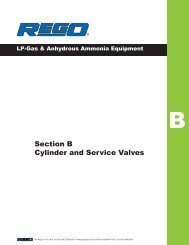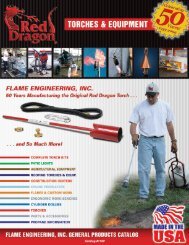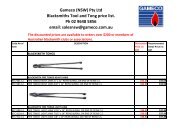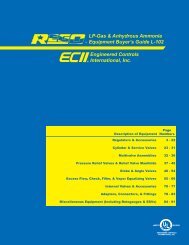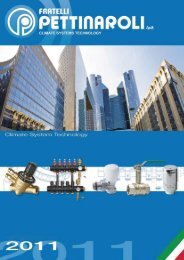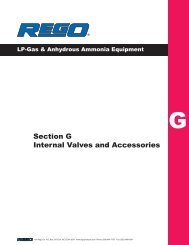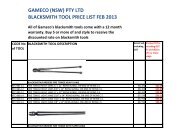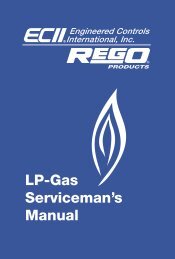- Page 3 and 4:
General Instructions, Notices, and
- Page 5:
General Instructions, Notices, and
- Page 8 and 9:
Repair Kits Available By Part Numbe
- Page 10 and 11:
Repair Kits Available By Part Numbe
- Page 12 and 13:
Repair Kits Available By Part Numbe
- Page 14:
Repair Kits Available By Part Numbe
- Page 17 and 18:
Kits Available for Obsolete Part Nu
- Page 20 and 21:
WARNING: Installation, disassembly,
- Page 22 and 23:
WARNING: Installation, disassembly,
- Page 24 and 25:
WARNING: Installation, disassembly,
- Page 26 and 27:
WARNING: Installation, disassembly,
- Page 28 and 29:
WARNING: Installation, disassembly,
- Page 30 and 31:
WARNING: Installation, disassembly,
- Page 32 and 33:
WARNING: Installation, disassembly,
- Page 34 and 35:
WARNING: Installation, disassembly,
- Page 36 and 37:
WARNING: Installation, disassembly,
- Page 38 and 39:
WARNING: Installation, disassembly,
- Page 40 and 41:
WARNING: Installation, disassembly,
- Page 42 and 43:
WARNING: Installation, disassembly,
- Page 44 and 45:
6. Carefully place the new disc ret
- Page 46 and 47:
WARNING: Installation, disassembly,
- Page 48 and 49:
of the poppet stem. 8. Lubricate ne
- Page 50 and 51:
WARNING: Installation, disassembly,
- Page 52 and 53:
WARNING: Installation, disassembly,
- Page 54 and 55:
3. Apply loctite to the threads of
- Page 56 and 57:
A3217F-50 Repair Kit for A3217FL &
- Page 58 and 59:
1. Lubricate existing outer stem be
- Page 60 and 61:
WARNING: Installation, disassembly,
- Page 62 and 63:
Disc Holder Subassembly 1. Assemble
- Page 64 and 65:
WARNING: Installation, disassembly,
- Page 66 and 67:
Disc Holder Subassembly - 1. Assemb
- Page 68 and 69:
WARNING: Installation, disassembly,
- Page 70 and 71:
8. Assemble the cotter pin into the
- Page 72 and 73:
WARNING: Installation, disassembly,
- Page 74 and 75:
to the closed position when release
- Page 76 and 77:
WARNING: Installation, disassembly,
- Page 78 and 79:
WARNING: Installation, disassembly,
- Page 80 and 81:
WARNING: Installation, disassembly,
- Page 82 and 83:
WARNING: Installation, disassembly,
- Page 84 and 85:
7188 Master Cylinder Repair Instruc
- Page 86 and 87:
ushing until holes are aligned. 9.
- Page 88 and 89:
WARNING: Installation, disassembly,
- Page 90 and 91:
WARNING: Installation, disassembly,
- Page 92 and 93:
WARNING: Installation, disassembly,
- Page 94 and 95:
WARNING: Installation, disassembly,
- Page 96 and 97:
WARNING: Installation, disassembly,
- Page 98 and 99:
WARNING: Installation, disassembly,
- Page 100 and 101:
WARNING: Installation, disassembly,
- Page 102 and 103:
WARNING: Installation, disassembly,
- Page 104 and 105:
WARNING: Installation, disassembly,
- Page 106 and 107:
WARNING: Installation, disassembly,
- Page 108 and 109:
WARNING: Installation, disassembly,
- Page 110 and 111:
WARNING: Installation, disassembly,
- Page 112 and 113:
WARNING: Installation, disassembly,
- Page 114 and 115:
WARNING: Installation, disassembly,
- Page 116 and 117:
WARNING: Installation, disassembly,
- Page 118 and 119:
WARNING: Installation, disassembly,
- Page 120 and 121:
WARNING: Installation, disassembly,
- Page 122 and 123:
WARNING: Installation, disassembly,
- Page 124 and 125:
WARNING: Installation, disassembly,
- Page 126 and 127:
WARNING: Installation, disassembly,
- Page 128 and 129:
WARNING: Installation, disassembly,
- Page 130 and 131:
7605B-50 and A7605B-50 Repair Kits
- Page 132 and 133:
9. Remove the plate gasket and disc
- Page 134 and 135:
WARNING: Installation, disassembly,
- Page 136 and 137:
WARNING: Installation, disassembly,
- Page 138 and 139:
Lock Lever Lever Spring Lever Pin A
- Page 140 and 141:
WARNING: Installation, disassembly,
- Page 142 and 143:
WARNING: Installation, disassembly,
- Page 144 and 145:
WARNING: Installation, disassembly,
- Page 146 and 147:
WARNING: Installation, disassembly,
- Page 148 and 149:
Flomatic Parts Key Component Part N
- Page 150 and 151:
Figure 4D: Exploded View of Flomati
- Page 152 and 153:
WARNING: Installation, disassembly,
- Page 154 and 155:
WARNING: Installation, disassembly,
- Page 156 and 157:
WARNING: Installation, disassembly,
- Page 158 and 159:
WARNING: Installation, disassembly,
- Page 160 and 161:
WARNING: Installation, disassembly,
- Page 162 and 163:
WARNING: Installation, disassembly,
- Page 164 and 165:
WARNING: Installation, disassembly,
- Page 166 and 167: WARNING: Installation, disassembly,
- Page 168 and 169: WARNING: Installation, disassembly,
- Page 170 and 171: WARNING: Installation, disassembly,
- Page 172 and 173: Figure 3a: Side View of Manifold As
- Page 174 and 175: WARNING: Installation, disassembly,
- Page 176 and 177: WARNING: Installation, disassembly,
- Page 178 and 179: Figure 4: Seat Ring Replacement Fig
- Page 180 and 181: Figure 8: Views of Manifold Assembl
- Page 182 and 183: WARNING: Installation, disassembly,
- Page 184 and 185: WARNING: Installation, disassembly,
- Page 186 and 187: WARNING: All gas MUST be evacuated
- Page 188 and 189: WARNING: Installation, disassembly,
- Page 191 and 192: WARNING: Installation, usage and ma
- Page 193 and 194: WARNING: Installation and use of th
- Page 195 and 196: Installation, usage and maintenance
- Page 197 and 198: WARNING: Installation, usage and ma
- Page 199 and 200: WARNING: Installation, usage and ma
- Page 201 and 202: 3119A and 3120 Unloading Adapters O
- Page 203 and 204: 3120 Angle Type Unloading Adapter U
- Page 205 and 206: WARNING: Installation, usage and ma
- Page 207 and 208: WARNING: Installation, usage and ma
- Page 209 and 210: A3209A050 1 1 /4" Internal Valve an
- Page 211 and 212: To determine if the pilot seat is o
- Page 213 and 214: WARNING: Installation, usage and ma
- Page 215: A3210A065 1 1 /4" Internal Valve In
- Page 219 and 220: WARNING: Installation, usage and ma
- Page 221 and 222: WARNING: Installation, usage and ma
- Page 223 and 224: WARNING: Installation, usage and ma
- Page 225 and 226: ➠ WARNING: Installation, usage an
- Page 227 and 228: Cable Control System The cable cont
- Page 229 and 230: WARNING: Installation, usage and ma
- Page 231 and 232: WARNING: Installation, usage and ma
- Page 233 and 234: A3217F Series 3" Internal Valves In
- Page 235 and 236: When there is excessive volume down
- Page 237 and 238: WARNING: Installation, usage and ma
- Page 239 and 240: A3219FA Series 4" Internal Valve In
- Page 241 and 242: opens valve. Premature closure may
- Page 243 and 244: A3219FPA Pneumatic Actuator for 4"
- Page 245 and 246: PNEUMATIC ACTUATOR INSTALLATION: NO
- Page 247 and 248: WARNING: Installation, usage and ma
- Page 249 and 250: WARNING: Installation, usage, and m
- Page 251 and 252: WARNING: Installation, usage and ma
- Page 253 and 254: WARNING: Installation, usage and ma
- Page 255 and 256: WARNING: Installation, usage and ma
- Page 257 and 258: WARNING: Installation, usage and ma
- Page 259 and 260: WARNING: Installation, usage and ma
- Page 261 and 262: WARNING: Installation, usage and ma
- Page 263 and 264: WARNING: Installation, usage and ma
- Page 265 and 266: WARNING: Installation, usage and ma
- Page 267 and 268:
Figure 4 Auxiliary Release System O
- Page 269 and 270:
WARNING: Installation, usage and ma
- Page 271 and 272:
WARNING: Installation, usage and ma
- Page 273 and 274:
7781AF Emergency Shut-Off Valves In
- Page 275 and 276:
Cable Attachment — see Figures 1
- Page 277 and 278:
WARNING: Installation, usage and ma
- Page 279 and 280:
A7883FK & A7884FK Flomatic Internal
- Page 281 and 282:
Key Components Flow Characteristics
- Page 283 and 284:
WARNING: Installation, usage and ma
- Page 285 and 286:
WARNING: Installation, usage and ma
- Page 287 and 288:
WARNING: Installation, usage and ma
- Page 289 and 290:
Relief Valve Replacement Before ins
- Page 291:
SUGGESTED MAINTENANCE GUIDE MultiPo



